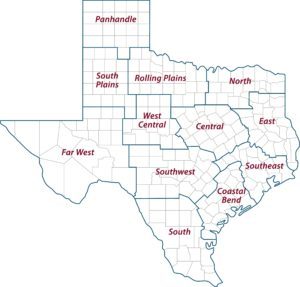Texas Crop and Weather Report – July 31st, 2019

[adning id=”33097″]

Alternative crops like sunflowers and sesame experienced a mixed year amid variable market conditions for the commodities that produce everything from oils to food products to viscosity enhancers used for oil well drilling.
Dr. Calvin Trostle, Texas A&M AgriLife Extension Service agronomist, Lubbock, said Texas producers planted fewer acres of the alternative crops in 2019 due to a variety of reasons from oversupply to the higher value of the U.S. dollar.
SUNFLOWERS
This year, Texas sunflower growers planted up to 40,000 acres, primarily in the High Plains, with about 8,000 acres in the Rio Grande Valley, Trostle said. Up to 30,000 of those acres were planted as oilseed, while a significant portion of acres were planted as bird feed.
Trostle said acres in South Texas have already been harvested, and good yields were reported. Sunflowers are planted later in the High Plains with harvests usually in October and November because they are cold hardy, tolerating temperatures as low as 28 degrees for a few hours.
Sunflowers are processed as birdseed or mixed with various millet and sorghum varieties to create a colorful blend that consumers and birds find appealing, Trostle said.
Trostle said the market for Texas confectionary sunflowers, those purchased to consume as a snack, had slowed due to record yields in the Dakotas and the strength of the U.S. dollar, which makes crops produced here more expensive overseas.
But there were almost 10,000 acres of confectionary sunflowers grown on contract, compared to zero acres in 2017 and 2018, he added.
“There are less (acres) than normal,” he said. “Oversupply has hurt prices and demand for planted acres.”
SESAME
Trostle said sesame, which is primarily used for food such as on hamburger buns, is having a better 2019 at market in comparison to last year. He said at least 50,000 acres were planted in Texas. Around 98% of the U.S. sesame crop is grown in Texas and southern Oklahoma.
A major contract buyer of sesame has continued to expand its operations over the past several years, he said. Texas producers have a technological advantage over producers around the globe via mechanical harvesting equipment to separate the seed from the pod with little yield loss.
“A lot of sesame is still hand-harvested globally due to dropped seed,” he said.
GUAR
Guar experienced another tough year at market, he said. Low prices have continued since the market ballooned in 2013. Trostle said about 20,000 acres were planted this season.
“Import prices were below market and made it difficult,” he said. “Guar is used in food and cosmetics, but a lot of it is used in the oilfield, where they are just looking for the cheapest commodity price.”
COWPEAS
Trostle said one alternative crop – cowpeas, including black-eyed and purple-hull peas – has always been a good rotation option, and experienced a good market in 2019.
The nitrogen-fixing associated with legumes is good for soil health and can help future row crops like cotton, he said. They are typically planted in the first half of July, and he estimated around 25,000 acres of peas were planted in the High Plains alone.
“Anytime is a good time to add legumes like cowpeas to a crop rotation,” he said. “Black-eyed peas, purple-hull peas and beans could be a good option because there are a lot of individual buyers, plus there’s canning and sale for dried peas.”
AgriLife Extension district reporters compiled the following summaries:
CENTRAL: Cooler temperatures were good for beef and dairy producers. Dry conditions were now the norm. Hot, dry conditions were drying rangelands and pastures. Some producers reported declining grass conditions while others reported good grazing and hay conditions. Peanuts and cotton were looking good. Corn acres for silage were mostly cut. Irrigation pivots were running. Fly numbers increased on cattle. Livestock were in good condition. Producers were busy cutting and putting up hay. A small chance of showers was in the forecast. Most counties reported good soil moisture.
ROLLING PLAINS: Conditions were cooler, dry and windy. Hay baling remained active in grass and sorghum, and Sudan varieties were being cut as well. Cotton fields were in fair to good condition. Rangeland and pastures were starting to show stress from the dry weather.
COASTAL BEND: Hot and dry weather was good for harvesting, but dry winds were rapidly decreasing the soil moisture. Grain sorghum harvest continued. Corn harvest began. Above-average yields were reported in corn and grain. Cotton bolls were opening, and many fields were already dropping leaves. Cotton harvest was picking up. Pastures and hayfields needed a good rain to stimulate fresh growth, but most pastures still had ample forage. Hay baling slowed, but there was a lot of hay harvested. Livestock were doing well.
EAST: A few areas received rain showers. Temperatures were cooler. Pastures were still green, but many areas were drying up. Pasture and rangeland conditions were fair to excellent. Producers continued to bale hay. Pond and creek levels dropped. Subsoil and topsoil conditions remained adequate. Cattle were in good condition. Wild pig control was underway. Armyworms, grasshoppers and Bermuda grass stem maggots were reported.
SOUTH PLAINS: Subsoil and topsoil moisture levels were drying out fast due to the heat. All counties needed rain. Cotton was squaring, and some plants were starting to bloom. Grasshoppers and green stink bugs were the only pest of consequences. Producers were finishing up fertilizer and spraying. Producers were also continuing to irrigate with no recent rainfall. Pasture and rangeland were reported to be in good condition.
PANHANDLE: Conditions were still hot and dry across the district. Adequate topsoil and subsoil moisture levels were reported in the northern portion of the district, while other parts were reporting poor rangeland conditions due to lack of moisture. Crops and pastures were suffering from the heat and needed rain. Due to wet weather earlier this spring, the corn and cotton were late across much of the region. Much of the cotton was in fair to poor condition, while most of sorghum was in fair condition. Many corn and soybean producers were irrigating fields. Producers were controlling weeds behind harvested wheat and fallow fields.
NORTH: Soil moisture was short to adequate across the district. Conditions continued to be hot and dry. Soil was cracking, and plants were showing moisture stress in the afternoon. Fields were drying quickly, and hay producers were working nonstop. Weather caused some progress in maturity of some crops, while grasses were challenged by weather patterns. Corn looked dry but wasn’t through dent stage yet. Cool-weather patterns allowed relief for livestock. Sugarcane aphids were in sorghum but not at high levels.
FAR WEST: Temperatures were in the high 90s. Rain amounts averaged 0.25 to 1 inch. High winds and dry conditions led to grass fires in drier areas, but most spots were no larger than 100 acres. However, Crockett County reported approximately 5,000 acres were burned. Producers began bailing hay and reported at least three bales per acre. Cotton progressed well, but most fields were behind the typical growth schedule. The outcome of late-planted crops will depend on the first frost. Most sorghum and corn were drying down, and a small number of acres were harvested. Alfalfa production continued, but most farmers were on their third cutting. El Paso County was expected to produce close to 50% of the state’s pecan crop. Weather was favorable for pecan production with very little pest pressure and adequate water supply. Rangelands still had plenty of grass for cow/calf producers in most of the district, but drier areas were giving herds some supplemental feed. Cow/calf producers were still working weaned calves and were administering a second round of shots in preparation for shipping.
WEST CENTRAL: Temperatures were cooler. Cotton grew well with the cooler temperatures. Sorghum and corn were maturing nicely and will be ready for harvest soon. Pastures were in good shape but were beginning to dry down after recent 100-degree days. Some field preparations began for fall planting of wheat and oats. Grasshoppers were still abundant. Stock tanks and livestock were in good shape. The cattle market opened with higher prices and good demand. Stocker and feeder steers and heifers both sold $1-$3 higher. Packer cows and bulls both sold $2 higher, while pairs and bred cows sold steady.
SOUTHEAST: Rangeland and pasture condition ratings were good to excellent. Soil moisture levels were adequate to short with adequate being most common.
SOUTHWEST: Conditions were starting to dry out rapidly with no rain and none in the forecast. Dry and hot conditions were taking their toll on rangeland and pastures. Corn harvest was underway in some areas and about to begin in others. Hay baling started. Despite unfavorable conditions, livestock and wildlife were in fair shape. Sutton County reported more confirmed anthrax animal deaths.
SOUTH: The district reported warm to hot weather conditions with short to very short soil moisture levels. Frio County reported some scattered showers and a cool front. Maverick and Zapata counties reported up to 1 inch of rain. Corn and sorghum were maturing well. In some areas, corn harvest was in full swing, and in Kleberg and Kennedy counties was complete, with yields averaging 100 bushels per acre. The peanut crop was in the pegging stage and being irrigated. Most cotton was in the mid-season stage and under irrigation. The first report of harvested cotton estimated yields at 750 pounds of lint per acre. Haygrazer and Bermuda grass were being cut and baled. Pasture and rangeland conditions continued to decline with lack of rainfall. Irrigated crops were all in good condition, including the Coastal Bermuda grass and other vegetables. Pecan orchards were also in good condition with no pest pressure reported. Native rangelands were mostly in fair condition but could use a good, soaking rain. Some areas reported poor rangeland conditions. Land preparation for fall planting began in some counties. Pastures and tanks were drying up in Dimmit County. Producers were still hauling water and providing supplemental feed. Hay was selling quickly with most producers paying $120 per ton or $60 per round bale. Cattle were still in good condition, and prices were steady to slightly higher on feeder calves and still low for cull cows and bulls.
[adning id=”33207″]
[adning id=”33207″]
[adning id=”33207″]














